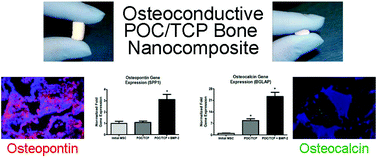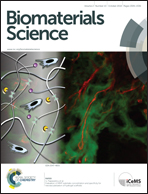Advanced nanocomposites for bone regeneration
Abstract
The field of orthopedic tissue engineering is quickly expanding with the development of novel materials and strategies designed for rapid bone regeneration. While autologous bone grafts continue to be the standard of care, drawbacks include donor-site morbidity and short tissue supplies. Herein we report a novel nanocomposite sponge composed of poly(1,8-octanediol-co-citrate) (POC) and the bioactive ceramic β-tricalcium phosphate (TCP). We show that these nanocomposite sponges can be used as a depot for bone-producing (a.k.a. osteogenic) growth factors. In vitro bioactivity is demonstrated by significant upregulation of osteogenic genes, osteopontin (∼3 fold increase), osteocalcin (∼22 fold increase), alkaline phosphatase (∼10 fold increase), and transcription factor, RUNX2 (∼5 fold increase) over basal expression levels in mesenchymal stem cells. In vivo osteogenicity and biocompatibility is demonstrated in a standard subcutaneous implant model in rat. Results show that the nanocomposite sponge supports complete cell infiltration, minimal adverse foreign body response, positive cellular proliferation, and cellular expression of osteogenic markers in subcutaneous tissue. The results shown herein are encouraging and support the use of this sponge for future bone tissue engineering efforts.


 Please wait while we load your content...
Please wait while we load your content...